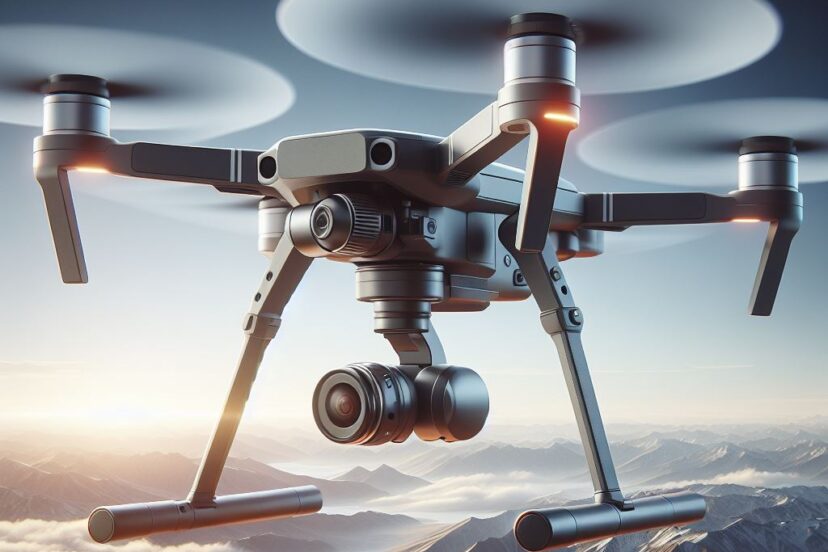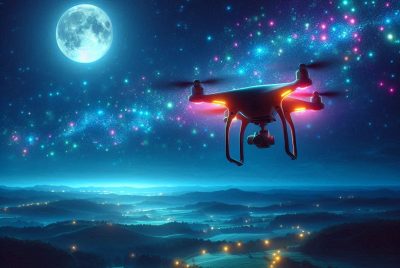Drone Gimbal Mastery: Unlocking Aerial Cinematic Brilliance
*We may earn a commission for purchases made using our links. Please see our disclosure to learn more.
Drone Gimbal Stabilization: Essential for Aerial Photography Precision
As a technology enthusiast with a keen interest in aerial photography, I’m often examining the latest advancements that enhance the quality and stability of my shots. A drone gimbal is a pivotal component in this regard, featuring a pivotal role in capturing smooth and unshaken footage from the sky. This piece of technology allows for precise control of the camera’s orientation, ensuring that even as the drone moves and turns, the camera stays level and steady, preventing undesirable motion from affecting the final image.

The technology behind drone gimbals is quite fascinating. Incorporating sensors and motors, gimbals utilize a system known as stabilization. This system counteracts the movements and vibrations of the drone, which are an inevitable part of flying. The result is that the camera attached to the gimbal maintains a consistent angle in relation to the horizon, providing clarity and stability that’s crucial for quality aerial photography.
Understanding the difference between a 2-axis and a 3-axis gimbal is essential when selecting the right equipment. A 2-axis gimbal stabilizes the tilt and roll of the camera, while a 3-axis gimbal adds stabilization on the yaw axis. This additional axis can make a significant difference in the smoothness of the footage, especially in challenging shooting conditions. As I navigate through the latest offerings and technological improvements in drone gimbals, it becomes evident that the potential for capturing high-quality aerial imagery is more attainable than ever.
Understanding a Drone Gimbal

In my coverage of drone gimbals, I will explore their development, compare different types, and break down their core components. These devices are critical for capturing smooth aerial footage with camera drones.
History and Evolution of Drone Gimbals
When I look at the history of drone gimbals, the trajectory is impressive. Initially, aerial footage was shaky at best, but the introduction of gimbals changed this. Starting with basic models that offered limited stability, the evolution of drone gimbals has come to a point where even amateur videographers can capture professional-grade footage. Technological advancements have led to the creation of sophisticated stabilization systems that are an integral part of today’s camera drones.
3-Axis vs. 2-Axis Gimbals
The two primary types of drone gimbals are the 3-axis and 2-axis gimbals, and the differences between them are substantial. Here’s what sets them apart:
- 3-Axis Gimbal:
- Axes of stabilization: Yaw, Pitch, Roll
- Motion Control: Smooth correction on all three planes
- Performance: Superior stability, more fluid footage
- 2-Axis Gimbal:
- Axes of stabilization: Pitch, Roll
- Motion Control: Correction on two planes; less control on yaw
- Performance: Generally less stable than 3-axis, but lighter and simpler
Admittedly, the choice between a 3-axis and a 2-axis gimbal hinges on the need for filming flexibility and the specific requirements of the aerial footage.
Essential Components of Gimbals
My focus on the essential components of gimbals narrows down to the motors and sensors that govern their function. These gimbals typically include:
- Motors:
- Type: Brushless motors
- Function: Precise movement control for camera stability
- Sensors:
- Types: Gyroscopes and accelerometers
- Function: Detecting drone’s movements and calculating adjustments
Understanding these components is crucial as they work together to provide the smooth, stable footage that drone cameras are known for. Constant adjustments to the drone’s motion are necessitated by the sensors’ input, and the motors’ precision is what keeps the camera level and steady during flight.
Selecting the Right Drone Gimbal

When I select a gimbal for a drone, I focus on ensuring compatibility, assessing load capacity for camera stabilization, and deciding between professional or hobbyist usage. Getting the right gimbal is crucial for capturing smooth, high-quality footage.
Compatibility with Drones and Cameras
I always check that the gimbal I’m interested in is compatible with both my drone and camera. Not all gimbals fit all drones, so I match the gimbal’s specifications to my drone model. When it comes to cameras, I confirm the gimbal’s mount type aligns with my camera—this is especially important for DSLR cameras that might need specific mounts.
Load Capacity and Camera Mount
The load capacity of a gimbal is crucial; it must be able to support the weight of my camera. I verify the gimbal’s maximum load capacity and compare it with my camera’s weight to ensure stability. For DSLRs, a sturdy camera mount is necessary to handle the heavier weight without compromising on camera stabilization.
Professional vs. Hobbyist Gimbals
My decision between a professional and a hobbyist gimbal depends on my intended use. Professional gimbals offer more advanced features and can accommodate heavier cameras such as DSLRs, leading to more precise stabilization. Hobbyist gimbals usually support lighter cameras and are more cost-effective but may have less advanced stabilization capabilities.
Advanced Features and Settings of a Drone Gimbal

In my experience working with aerial cinematography, mastering the advanced features and settings of a drone gimbal can significantly enhance the quality of the footage.
Calibration and Stabilization Settings
I’ve learned that precise calibration is essential to optimize the performance of the stabilization system. Before flying, I always ensure the gimbal’s calibration to align with the drone’s center of gravity. This involves adjusting the:
- Pitch: To ensure the camera tilts smoothly up and down.
- Roll: To keep the horizon level during lateral movements.
- Yaw: For stable panning, reducing any unwanted rotational shake.
Most high-end drone gimbals, like those from DJI, offer automatic calibration features that simplify this process, while manual fine-tuning can further optimize stabilization for specific shooting scenarios.
Follow Mode and ActiveTrack
Follow Mode is a setting I frequently use to achieve dynamic shots. It allows the gimbal to:
- React: To the drone’s movements smoothly, maintaining the camera’s focus on the subject.
- Adjust: The camera’s orientation gently, based on the drone’s trajectory and speed.
ActiveTrack technology, particularly in DJI models, enhances this functionality by:
- Locking: Onto a moving subject automatically, keeping it centered in the frame.
- Adjusting: The gimbal’s movements in real-time to follow the subject’s path accurately.
These features require careful management to ensure they operate correctly, including calibrating the system to recognize and track subjects.
Firmware Updates and Manufacturer Support
As a drone operator, I stay informed about the latest firmware updates provided by the manufacturer. These updates can:
- Enhance: Performance and introduce new features to the gimbal.
- Resolve: Bugs and improve the overall stability of the system.
I always recommend reaching out to the manufacturer’s support for guidance on firmware upgrades and to access resources for troubleshooting any issues. DJI, as a leading manufacturer, consistently offers substantial support and firmware enhancements for their gimbal systems. Regular updates ensure that my equipment remains at the forefront of technology, reliability, and performance.
Drone Gimbal: Practical Usage Tips

To ensure the best performance from my drone gimbal, I focus on battery efficiency, minimizing vibrations, and achieving smooth footage. These factors are critical for the quality of the aerial cinematography.
Optimizing Battery Life for Extended Usage
To optimize battery life, I regularly calibrate my drone’s power settings and plan my flight paths efficiently. Here’s how I make my battery last longer:
- Reducing Weight: I remove unnecessary accessories to decrease power consumption.
- Pre-Flight Checks: Before taking off, I ensure batteries are fully charged and stored at optimal temperatures.
- Power Settings: I adjust the drone’s power settings to eco-mode when possible, reducing the drain on the battery.
Avoiding Vibrations and G-Forces
Excessive vibrations and G-forces can degrade the quality of footage. Here’s what I do to mitigate them:
- Balanced Propellers: I always check that my propellers are balanced to prevent shaking due to uneven rotations.
- Gentle Maneuvers: I execute smooth and slow flight maneuvers to avoid sudden g-forces which can cause the gimbal to work harder.
Achieving Smooth Footage
For smooth footage, maintaining a stable gimbal is paramount. My methods include:
- Gimbal Tuning: I fine-tune gimbal settings to match the flight conditions.
- Steady Pace: I maintain a steady pace when flying, as high speeds can result in jerky movements.
By adhering to these practices, I maintain my drone and gimbal in peak condition, ensuring that I can capture exceptionally stable and clear footage.
Drone Gimbal: Accessories and Additional Equipment

When discussing drone gimbals, the right accessories can greatly enhance both the shooting experience and the quality of the footage. From essential add-ons that every drone enthusiast should consider, to specific products for DJI drone stabilization systems, I’ll cover the add-ons that proportionately enhance the utility of your gimbal.
Essential Gimbal Accessories
The foundation of any drone gimbal’s performance is the accessories that support its operation. Here’s a condensed list:
- Spare Batteries: To ensure extended shooting sessions without interruption.
- Camera Cables: For a seamless connection between your camera and gimbal.
- Balancing Counterweights: For fine-tuning the gimbal’s balance with different camera setups.
- Carrying Case: To protect your gimbal and accessories during transport.
Integrating Handheld Stabilizers
Handheld stabilizers like the DJI Ronin series take your cinematography to new levels, letting me capture smooth and stable footage on the move. The integration process usually involves:
- Mounting Plates: For securing the gimbal to various camera systems.
- Control Cables: To allow me to adjust camera settings directly from the gimbal handle.
- Extension Arms: When I need to accommodate larger camera setups or add accessories.
DJI Specific Add-Ons
Within the DJI ecosystem, there are a myriad of add-ons designed to improve your experience:
- DJI Store App: I make sure to use the DJI Store App to find the latest accessories and updates for my DJI gimbal.
- DJI Credit: Can be used to purchase a wide range of accessories, sometimes at a discount.
- DJI Care Refresh: A service plan offering replacement units in case my gimbal gets damaged. It’s a great investment for peace of mind.
- Specialized Goggles: For an immersive FPV (first-person view) flying experience.
Leveraging these accessories and additional equipment properly ensures that my gimbal is not only protected but also used to its fullest potential, enabling me to capture compelling and high-quality footage.
FAQs About a Drone Gimbal
In my experience with drones and gimbals, these are some of the questions that come up often. I’ll address each one with the technicalities and details that should help clarify the common inquiries about drone gimbals.
1. How does a 3-axis gimbal improve video quality on drones?
A 3-axis gimbal stabilizes a camera on the yaw, roll, and pitch axes. This ensures smooth footage by compensating for unwanted drone movements and vibrations during flight.
2. What features should I look for in a drone gimbal with a camera?
Look for features like a high-precision motor, real-time response to movement, compatibility with your drone, and the ability to support a range of camera weights for versatility.
3. What is the typical price range for a high-quality drone gimbal?
Based on my research and market analysis, high-quality drone gimbals typically range from $100 to several thousand dollars, depending on features and brand reputation.
4. Which drone gimbal is considered the best on the market?
The best gimbal can vary widely based on use case, but consistently, brands like DJI are highly regarded for their advanced stabilization technology and build quality.
5. How does 4K camera integration enhance drone gimbal performance?
4K camera integration with a gimbal provides ultra-high-definition footage, making any stability and precision offered by the gimbal even more critical for professional-quality results.
6. What are the key differences between 2-axis and 3-axis drone gimbals?
A 2-axis gimbal stabilizes roll and pitch, while a 3-axis gimbal adds stabilization for yaw. The additional axis on 3-axis gimbals provides more comprehensive stabilization, particularly during complex maneuvers or strong winds.




